 The greatest irony in Star Wars: Revenge of the Sith is that the original generation of Star Wars fans have, through their constant complaints about the prequel trilogy, forced George Lucas to make a film that many of them would have been unable to watch when they first fell in love with his universe.
The greatest irony in Star Wars: Revenge of the Sith is that the original generation of Star Wars fans have, through their constant complaints about the prequel trilogy, forced George Lucas to make a film that many of them would have been unable to watch when they first fell in love with his universe.
Revenge of the Sith is rated 12a (13 in America) – a rating that, if it had been enforced for the earlier films would have excluded many of those who have gone on to be the franchise’s most devoted fans. This nastier, darker movie has been born out of the constant whinging of older fans who found the new films disappointing.
Star Wars, of course, wasn’t made for thirty-something fanboys but for children. It is precisely because these films are childish that they carry so much importance for so many people. Star Wars is the most potent fairytale for a whole generation and, as such, it has become imbued with all the signifiers of childhood – innocence, simplicity and freedom.
With that baggage, the sensible assessment of the original trilogy is almost impossible and a convenient amnesia prevents fans recalling its flaws. Those who felt “betrayed” by the silliness of Jar Jar Binks conveniently forget the irritating Ewoks. Those who whined about the lengthy discussions of politics in Attack of the Clones. forgive the inane cod-philosophical burblings of Yoda in The Empire Strikes Back.
The first generation of fans have spent twenty years justifying their continued devotion to these childish films, wrapping them in tightly-woven layers of mythology, weighing them down with undue significance. They have forgotten that they first fell in love with simple emotions, thrills and, yes, corny dialogue.
Not that Revenge of the Sith is a bad film. It’s got piles of action, fabulous special effects and some effective, character-driven drama. There are problems – it takes a while to really get going, Count Dooku is despatched too quickly and General Grievous isn’t half as menacing a villain as the animated series, The Clone Wars, made him appear.
But most of the last hour, from the fall of the Jedi to the showdown between Anakin (Christensen) and Obi Wan (McGregor) is magnificently realised. There is an operatic quality to this section and the cast suddenly spring to life.
McGregor sparkles as, at last, he is allowed to act and express emotion. Jackson’s Mace Windu goes down in a blaze of glory. Even the wooden Christensen becomes animated. But this film belongs to McDiarmid as the wonderfully pernicious, subtle and (yes) insidious Chancellor/Emperor Palpatine. Crucially for the credibility of all six films, McDiarmid is so utterly persuasive that we not only understand Anakin’s choices, we almost sympathise with them.
If you don’t understand why a sequence of children’s films grips so many people, Revenge of the Sith will not enlighten you.
If you are a six or seven-year-old, for whom your Star Wars will always really be about Gungans and pod-racing, Revenge of the Sith may be a little bewildering, when you are old enough to be allowed to watch it.
If, however, you are a first generation fan, sit down and relax. This is the film you are looking for. It might not feel as good as the first time (these days, what does?) but stop whinging now. You won.
THE POLITICS OF EMPIRE
If anything in the Star Wars prequels can challenge Jar Jar Binks for the sheer hatred poured upon it, the the emphasis Lucas placed on the political manoeuvring that leads to the decline of the Republic must come close. Trade wars and tax disputes were not the droids Star Wars fans were looking for.
Politics doesn’t feature much in science fiction. There’s plenty of ideology and plenty of SF is willing to promote (or attack) “big ideas”. But when it comes to the processes by which decisions are taken in a working society – the day-to-day reality of politics – SF yawns. Politicians of the democratic sort tend to be dismissed as corrupt, inept or bureaucratically hidebound.
Not only does Lucas take politics seriously, but he has made the defence of democracy the key message of his films. His case for the importance of liberal politics is as central to the new trilogy as myth-making was in the original.
The prequel trilogy can be seen as retelling American history. It proceeds from a war of independence instigated by a row over trade through the corruption of idealism by increasingly powerful military/industrial interests to the final betrayal of the republican ideal by a politician bent on attaining supreme power through the manipulation of a military crisis. From Washington to Nixon to George W in three films.
Lucas makes three crucial points.
First, politics, despite its flaws, can be a force for good. Padmé is central to this point, in Episode II she says: “The more I studied history, the more I realised how much good politicians could do”. That is a sentiment that is vanishingly rare in SF! Actually it’s a sentiment that’s vanishingly rare in wider society as well. Alongside Palpatine and the mass of corrupt senators Padmé (with Bail Organa) displays a selfless concern for the wider public good.
Second, Lucas highlights the dangers of unrestrained populism and jingoistic militarism. The militarisation of the Republic, the centralisation of power in the face of a manufactured crisis and the spread of fear create the conditions for a coup. Meanwhile, the corrupt Sith become protectors of “homeland security”. Palpatine defends the abolition of the rights of the old Republic as necessary for a “safe and secure society”. The only price is freedom.
Finally, Lucas stresses that politics is, in Bismarck’s (the creator of modern Germany, not a character in any SF movie) phrase, “the art of the possible”. When, in Episode II, Anakin says that what we need is “a system where the politicians sit down and discuss the problems, agree what’s in the best interests of all the people and then do it,” Padmé is quick to challenge him. The competing interests of citizens are not so easily dismissed, she tells him. Anakin’s response is that dissenters should be forced into consent which, as Padmé points out, is not democracy but dictatorship.
The Republic is, of course, doomed and it falls to Padmé to put the final nail in the coffin when she confesses to Anakin that even she no longer believes in the cause for which they are fighting. “What if the democracy we thought we were serving no longer exists,” she tells him, “and the Republic has become the very evil we have been fighting to destroy?” This conversation heralds the beginning of the darkest hour in any Star Wars movie as the Jedi and the Republic sink beneath an ocean of slaughter. But, it would be a mistake to imagine that Lucas has surrendered to pessimism. Even as Palpatine (literally) tears the senate apart in his attempt to destroy the last of the Jedi, we know he will fail. After all, a rebellion is just around the corner and an unborn boy called Luke has a destiny to fulfil.
LOVE HURTS
The weakest element of the Star Wars prequels has been the love story between Anakin (Christiansen) and Padmé (Portman). It may be thirty years since American Graffiti but it seems incredible that the director who sublimely captured the awkwardness of teenage love then should have failed so completely now.
Casting was a weakness – Christensen is no Richard Dreyfus and Portman never seemed to cope with the demands of effects-led movie-making.
It was not just the actors’ fault. Lucas has always had limitations as a writer of dialogue and he was often out of his depth, dropping the ball most obviously in Attack of the Clones.
One of the most pleasing things about Revenge of the Sith is the way in which the love story pays off, providing a human reason for Anakin’s switch to the dark side.
Portman and Christensen never develop real chemistry, but Anakin’s torment, and his conviction that his actions are not just right but necessary, provides the core of Revenge of the Sith with a more subtle and convincingly human motivation than might have been expected.
Ultimately, Anakin does not succumb to the Dark Side because he wants power for his own sake. Nor does he ever simply choose evil over righteousness. There may still be good in him, but love has convincingly lead Anakin to fear – and every fan knows that fear leads to hate and hate leads to suffering.
